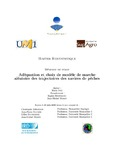|
Resumen:
|
The study of movement of organisms is essential for understanding how ecosystems work. In the case of exploited marine ecosystems, it allows the understanding of spatial strategies of shermen. One of the most commonly used approaches for modeling top predators movement is the Lévy random walk. A random walk is a mathematical model composed of random steps. In Lévy random walks, the length of the steps follow a stable Lévy distribution. Also Lévy random walks, when lengths of steps tend to in nity (in practice, when lengths of steps are large, say, compared to the median or the third quartile), they follow a power law distribution which characterizes the type of Lévy random walk (Cauchy, Brownian or strictly Lévy). In practice, this property is used on a reciprocal basis without any theorethical foundations. Apart from this fact, tail distributions are modeled by power laws without rst discussing important issues as the sensitivity of the results to the de nition of tail distribution, the relevance of goodness-of- t tests and of model selection criteria. In this work regarding observed movements of three Peruvian anchovy shing vessels, several models for the tail distribution are compared (lognormal, exponential, truncated exponential, power law and truncated power law) as well as two possible de nitions of tail distribution (from the median to the in nite or from the third quartile to the in nite). In terms of the statistical tests and criteria that were used, truncated distributions (exponential and power law) appeared to be the best. Among other things, they incorporate the fact that, in practice, the boats do not exceed a certain limit on length of steps. Model selection appeared to be sensitive to the choice of the beginning of the tail : for the same boat, choosing one truncated models or the other depends on the range of values of the variable on which the model is adjusted. Finally, we discuss the implications of the results of this work in ecology.
|








 Lire la suite
Lire la suite
